The Real Seed Catalogue
2010 Newsletter
Welcome to our annual Newsletter, where we try to show a few of the things we have been working on over the past year, give a you a sneak preview of the veg we are trying out for the future, and show you a bit of what goes on in the background behind the scenes.
A very cold and late Spring . .
We've noticed this spring that with the cold nights in particular we have had more calls and emails this year from people who have been struggling with germination especially with some of the more tricky vegetables like peppers and aubergines.
It's worth remembering that seeds do need reliable warmth to get going, and often windowsills and greenhouses may not actually be as hot as you think, even on a sunny day.
In particular, even when days are warm, if the seeds get chilled at night, they may well (quite sensibly) refuse to germinate! We've got some hints and tips in our information section, along with other articles about seedsaving, sowing times and storing your seed.
The 2010 Growing Season
Summer has come round, and everything in the garden is (so far) growing nicely, so it seems as though in no time at all we're here again with the newsletter. At the moment (in early June) we're enjoying some nice sunny weather, so after the cold winter and late spring things are starting to get going.
This year we've been working hard to cultivate our newly rented field and get the weeds under control. Our neighbour Tony did a great job of traditionally hand-laying the overgrown blackthorn hedge last winter, and the neighbouring farmer helpfully repaired his boundary fence before putting 40 cattle up against it, so it has come back really well this spring. You can see the restored hedge on the right.

It's hard to believe that a year ago the seed-beds above were a jungle of 10-foot high scrub that took three people with chainsaws several days to clear. Following on from them, our baby Kubota tractor has been doing a great job of breaking the sod and preparing the soil ready to plant, but we still do most of the cultivation by hand (there's an article lower down this newsletter about all our various weeding tools).
 In addition to this 1-acre field we rent , this year we managed to buy two nearby 1-acre fields as well. These will need a lot of work to fence and get under cultivation, but in the long-term they will allow us more space to grow different varieties and provide isolation space so things don't cross.
In addition to this 1-acre field we rent , this year we managed to buy two nearby 1-acre fields as well. These will need a lot of work to fence and get under cultivation, but in the long-term they will allow us more space to grow different varieties and provide isolation space so things don't cross.
They are a bit windswept (you can see the sea from one of them) but once we have windbreaks planted and established they should be fine.
In this picture (right), the field at the bottom right is the rented one, which since this aerial photo was taken has been put down to seed crops as you can see in the big picture above.
The fields on the left are the ones we have bought. The white stripes at the bottom are plastic crop covers put down by a neighbouring farmer (and sadly the very nice farmhouse on the right is not ours!)
Although there's a lot of weeding to do, we're enjoying having plenty of space to try out new things, and hopefully over the next few years there will be quite a few interesting new varieties coming into the catalogue once we've had time to complete our trials and multiply things up.
Real Seeds News
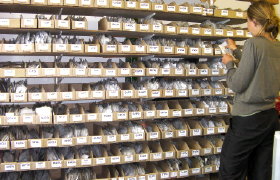 A few changes this year at Real Seeds - from previous newsletters you'll know that we (Ben & Kate) don't do it all on our own but normally rely on our stalwart seed packers (Anja van Hees and Kate Squire) to make up all the little packets of seed, plus Catherine to help run the office and pack all your orders.
A few changes this year at Real Seeds - from previous newsletters you'll know that we (Ben & Kate) don't do it all on our own but normally rely on our stalwart seed packers (Anja van Hees and Kate Squire) to make up all the little packets of seed, plus Catherine to help run the office and pack all your orders.
This year Catherine has been off on a years' maternity leave, looking after her new baby Eli.
In her place we've been joined in the office by Felicia, who has been really efficient and cheerfully helped keep everything running smoothly even at the peak of the season. You can see her here packing orders from our expanded seed racks in the new office.
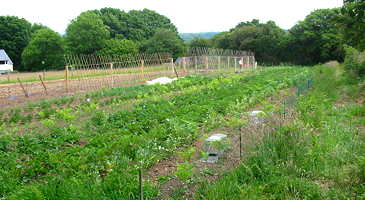
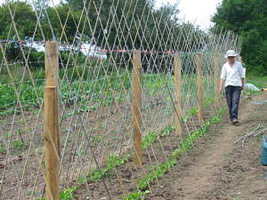
New things in the garden this year
Ben has been very busy in the last week constructing a huge run of good sturdy supports for climbing beans and peas. We are very pleased to have re-introduced the Champion of England pea as a trial last year and with luck it will be available in proper quantities for the first time this year.
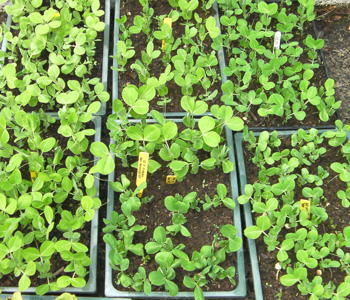 And we still have a whole pile of interesting old UK (and other) heirloom varieties to try out, here they are in trays ready to be planted out once the supports are done.
And we still have a whole pile of interesting old UK (and other) heirloom varieties to try out, here they are in trays ready to be planted out once the supports are done.
We'll be growing Fairbeards' Nonpareil, Glory of Devon, Lancashire Lad, Lord Leicester, Magnum Bonum, a black seeded drying pea from Northern Spain and plenty of others this summer, so hopefully some will be worth continuing with and there will be more good peas coming along.
If they do well, we'll bulk them up and you will see them in the 2012 or 2013 catalogue.
As well as the peas, we're also growing a new (to us) runner bean this year. Black Beauty or Miners' Bean was given to us by Bob Mitchell, who has grown it for many years, but got it originally from a foundry worker in Pontyprydd.
He says that it had been grown by miners & others in the area since at least the second world war - hence the name.
We are looking forward to seeing whether it will perform as well for us in West Wales. Bob also gave seed of the bean to the Welsh Seed Search project, so their volunteers will also be growing the bean in other parts of the country.
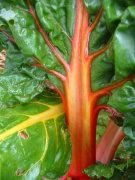
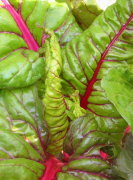 On our field there is also a bed of Ben's Magic Chard, a long-term (since 1998) breeding project that was last offered a couple of years back. Right now the plants are all very small, but a bit later he will crawl down the rows, carefully selecting the baby plants that have particularly interesting stem colours, and weeding out the rest.
On our field there is also a bed of Ben's Magic Chard, a long-term (since 1998) breeding project that was last offered a couple of years back. Right now the plants are all very small, but a bit later he will crawl down the rows, carefully selecting the baby plants that have particularly interesting stem colours, and weeding out the rest.
The chosen ones will grow over the summer (we'll get rid of any that aren't vigorous or productive) and then they'll be left overwinter. Chard is a biennial, so it won't seed until the following spring, ripening in mid-2011.
Harvest permitting, this should make it to the website for the 2012 catalogue. We have been selecting for glowing oranges and reds, as well as interesting combinations with dark leaf colours.
There are small runs of other interesting seed growing as well - we have some unusual naked barley, and also some edible seeded lupins on trial. We've noticed that the leaves of the lupins follow the sun throughout the day, just as sunflowers do.
The Real Seed Collection 2010 vegetable trials
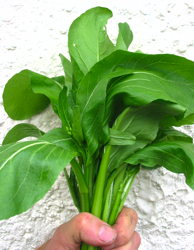 For those of you who are new to us, each year we collect and try out all sorts of new vegetable varieties to find good new things to add to the catalogue. Only if something meets our simple but strict requirements does it get added:
For those of you who are new to us, each year we collect and try out all sorts of new vegetable varieties to find good new things to add to the catalogue. Only if something meets our simple but strict requirements does it get added:
- it has to be really easy to grow,
- it has to give a good yield,
- and it has to taste great.
Anything that can't live up to these 3 premises will be thrown away!
This year we are trying out several new things that you may (or may not) see in 2012 onwards:
Our oriental greens are always very popular, especially for summer and autumn sowing, as they are so easy and productive. This year we're trying out a whole selection of brand new varieties. Vivid Choi and Purple Rapa are already living up to their names and looking very colourful - we'll be sowing those plus a whole lot more at various times throughout the season to find out if and when they do well.
We've also been trialling a number of vegetable varieties originally from the Czech Republic. Over the years we've grown many excellent vegetables from eastern Europe that do really well in British conditions, including our Kaibi and Napia sweet peppers from Bulgaria.
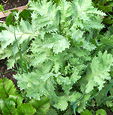 This year we are trying out several root vegetables from the Czech Republic, and also a couple of breadseed poppies. Its too early yet to know how they will do, but we will doubtless be writing more about them in future years.
This year we are trying out several root vegetables from the Czech Republic, and also a couple of breadseed poppies. Its too early yet to know how they will do, but we will doubtless be writing more about them in future years.
We are also trying - with some skepticism - outdoor tomatoes that are reputed to be blight-resistant. Unfortunately at the moment there is no such thing as a completely blight-proof tomato, but it is possible we will find some tolerance which will allow you to get a crop before the plants succumb to the disease. Two that are doing particularly well so far are 'Siletz' and 'Legend'.
This summer we also have a trial of parsnips, with a Czech variety compared against our usual stalwart 'Tender & True'. We have some other parsnips to try next year too - including Offenham Parsnip, and Cobham Improved parsnip. These were meant to be in this years' trial too, but the seed arrived too late, so they'll be planted out next spring.
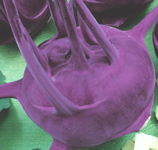 And finally, we are running a trial of Kohl Rabi . At the moment its too early to tell, but we think the deep blue one 'Azur' and the 'Giant' are the front runners.
And finally, we are running a trial of Kohl Rabi . At the moment its too early to tell, but we think the deep blue one 'Azur' and the 'Giant' are the front runners.
We have a range of different types under trial - some are quick and tender, others grow really huge and are for storage overwinter, and we hope to add one of each type to the catalogue in the future.
Website improvements - new Seed Selection buttons, and pictures.
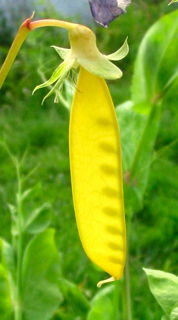 Away from the garden we have been trying to improve the website wherever we can to make it easier to use and more helpful. Whenever we get time we try to update the seed saving instructions, they are now pretty good.
Away from the garden we have been trying to improve the website wherever we can to make it easier to use and more helpful. Whenever we get time we try to update the seed saving instructions, they are now pretty good.
Every year we also try to take new pictures to give a better idea of what the plants are like, and replace any of the ones on the website that aren't the best. This summer we have got some much better photos, including a wonderful new shot of our Golden Sweet Pea.
As well as the information pages, Ben has figured out a way of putting together handy lists of recommended seeds for those who find it hard to choose between the options available. Now with just one button you can add a list of suggested varieties to your cart:
So far he has made an Orientals list and a Summer Sowing list, but we will also be putting together a beginners list for people who are just starting with a new garden or allotment.
Unlike our Gift Collections, these don't come physically packaged up together, and once they are added to your cart you can go through and delete any varieties that you don't want, so they should be better for people buying for their own garden.
New in the catalogue this autumn

There are quite a few new things that should be worth checking out in the new catalogue this October. Last year we tried offering the Mortons' Secret Mix of lettuces, which was a huge hit. We have just got new seed from lettuce experts Frank & Karen this year, containing a new mix of their latest breeding varieties, guaranteed to have something for everyone in it!
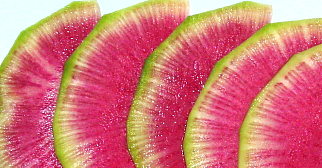 We also have an exciting new radish. Now, you might not think radishes are exciting, but you just try our new 'Red Flesh' radish! This is a large and mild flavoured radish that can be used raw or indeed is very good cooked.
We also have an exciting new radish. Now, you might not think radishes are exciting, but you just try our new 'Red Flesh' radish! This is a large and mild flavoured radish that can be used raw or indeed is very good cooked.
Not only are they outstandingly pretty sliced with a deep pink inner shading to white & green outer (picture right at actual size) , they also stand well for us in the ground.
We find them ideal for adding the 'crunch' that a good salad needs outside of the cucumber season, without the fierce heat of a smaller radish.
 Ben's latest discovery is Hamburg or root parsley. Its another good reliable root vegetable that will add a bit of variety to your diet over the winter months and into springtime.
Ben's latest discovery is Hamburg or root parsley. Its another good reliable root vegetable that will add a bit of variety to your diet over the winter months and into springtime.
They're grown much like parsley (though in our experience are a bit easier to germinate), and has a mild slightly sweet flavour that is good either mashed or roasted as 'root parsley chips' in the oven.
There should also - harvest permitting - be the Champion of England Pea finally available in quantity and maybe even a small reduction in price if the crop is good, and we hope to add Dill to the Herbs section, and Aquadulce Claudia broad bean to the Beans part.
We are also experimenting with a new grower, Ian Hearne, who does a fantasic local organic veg box scheme. He is growing some new Rocoto Pepper seed for us this summer. We handed over 3 small precious baby plants last weekend - this is just a small trial to see how it works for him and us , and how well it fits into his cropping calendar.
Because of the number of different things we grow, it would be great for us to find a small professional grower who can work with us; if all goes according to plan you should see the Gothenburg Rocoto seed from him in the web-catalogue this autumn, and maybe we will work with Ian again next year to produce some more varieties.
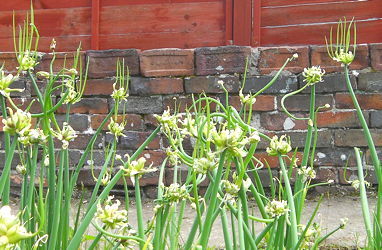
And for those of you who are hoping to grow topsetting or walking onions,
we have again planted a bed of Topsetting onions,
and they should be available on the website later this summer.
Our new Precision Push Seeder
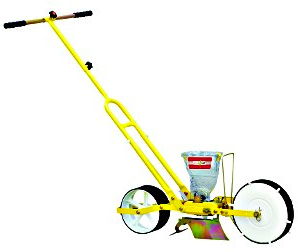 Our newest tool is a precision push seeder. Although we've only used it a little so far, we think it is going to be very helpful in getting long rows of vegetables sown quickly and efficiently.
Our newest tool is a precision push seeder. Although we've only used it a little so far, we think it is going to be very helpful in getting long rows of vegetables sown quickly and efficiently.
As well as being quicker than sowing by hand, it seems to be much easier to get a really straight row which makes hoeing much easier, especially with the wheel hoe. It also places one seed neatly at the spacing that we choose, so it should mean much less thinning, as well as using less seed.
The push seeder is from Korea, where they do vast amounts of small-scale growing, and the government has put a lot of effort developing into human-scale implements.
It is made by Jang Industries, and is a modernization of the old-fashioned row seeders like the Planet Junior or Cole. The basic difference is that the older seeders pretty much pour out the seeds in a straight line as you walk along, while a precision seeder picks up individual seeds one at a time and places them at exactly the spacing you choose.
This really helps with the rarer stuff where we don't have a lot of seed to spare but still need to sow a big area to get a decent crop - for example our Manchester Table Carrot, we manged to sow about 150 ft of row using just a few tablespoons of seed.
Local seedsaving projects
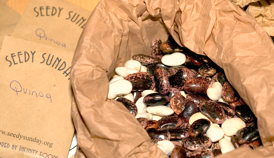 'Seedy Sunday' seedswaps seem to have become well established now in lots of different areas (too many to list - but just google 'Seedy Sunday' to see if there is one near you).
'Seedy Sunday' seedswaps seem to have become well established now in lots of different areas (too many to list - but just google 'Seedy Sunday' to see if there is one near you).
Surely the next step should be for local gardeners to start collecting and developing their very own local adapted selections of seeds?
Well, the Dyfi Valley seedsavers have started already with their Welsh Vegetable Project. They are searching for seeds that are special to Wales - bred in the country, with a special history, or where the seed has been grown in Wales successfully for many years. If you have any special Welsh varieties, you can get in touch with them through their website.
We of course are always happy to know about old special varieties you may be maintaining with a long local history, be they Welsh, English or Scottish.
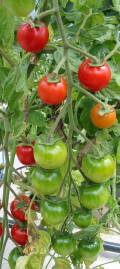 Our on-going 'super-early-tasty-tomato' breeding project is now in its 5th year with some excellent vine tomatoes being multiplied up for us by Tony Haigh. It appears that our particular selection is now stable for 'vine' type and we just need to settle on the final flavour we prefer.
Our on-going 'super-early-tasty-tomato' breeding project is now in its 5th year with some excellent vine tomatoes being multiplied up for us by Tony Haigh. It appears that our particular selection is now stable for 'vine' type and we just need to settle on the final flavour we prefer.
We'll lay them all out on the table and let our friends decide in a grand tomato-tasting session. Those will be the ones we sow from next year.
In the past, every gardener was a plant breeder. So we also made seed from these breeding lines available on our website last year and an astounding 368 of you are also joining in - having requested seed of either the Vine or Bush breeding lines.
This is a great parallel-breeding project and by now we think you should all have big plants with lots of very early green tomatoes set on them. But every one will taste and grow a little differently from the others. . .
Remember, you need to taste & evaluate all the plants you grew and save seed from just 1 tomato from your one favourite plant. Do this for 3 or 4 more years and you will have your own super-early tomato.
Do let us know how you get on. (We may not be able to reply to all, but we promise we will read them & take note!)
Wonderful Books
Although we only sell a couple of books directly ourselves there are a few other books that we've found helpful, and thought worth a mention here.
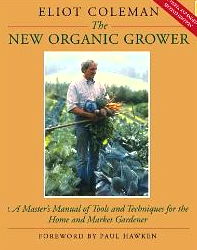 Eliot Coleman's book 'The New Organic Grower' is aimed at the small market gardener, but is fascinating for anyone who is serious about growing vegetables on a larger scale, whether for their own use or for sale.
Eliot Coleman's book 'The New Organic Grower' is aimed at the small market gardener, but is fascinating for anyone who is serious about growing vegetables on a larger scale, whether for their own use or for sale.
We've found his ideas about tools and tool use, green manuring, rotations and planning invaluable in developing our gardens.
On a completely different scale, 'Patio Produce' by Paul Peacock is intended for those who have no vegetable garden as such, and have to do all their growing in containers. Its a very practical book which should help beginners who want to know what they can plant, how big a container they need to use, and what the best ways are to get the best return from a very small space.
Moving on from gardening to seedsaving, Carol Deppe's book 'Breed your own Vegetable Varieties' goes one step on from the Sue Stickland seedsaving book (also highly recommended), and shows you how to start breeding your own varieties.
Although she does go into the genetics that underpin breeding, its very readable for non-scientists. In fact, the background information is really helpful for seedsaving in general, since as well as helping you to develop your own varieties, it is equally useful if you want to make sure that you are maintaining an existing variety true to type and with good vigour.
Finally, we have just realised that we should update our website. We've recommended Joy Larkcom's book Oriental Vegetables before, but at that time it was out of print, and only available second hand. Its good to see that it has now been reprinted.
If you fancy getting any of these from your library, then all the details (ISBN etc) are on our books page.
Peak Everything - teach your kids to save seed & grow their own veg
"Economic Growth" - the idea that we all will have more and more stuff faster and faster, for ever -
is simply not possible on a finite planet.
In fact, economic growth depends on consuming more and more fossil fuels at an ever increasing rate. Unfortunately, we actually have less and less fuel each year now as we started to run out in 2008. For a few years we substituted borrowed money to continue the illusion, but even that is no longer sustainable, as seen by the fact that every country is in debt and no-one can repay it all.
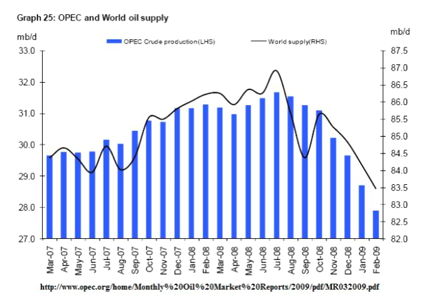
So, in the future, in a 'growthless' economy , we will all have quite a bit less 'stuff' each year, and spend a bit more time doing real work like growing vegetables. This is inevitable, and will indeed require real readjustments to society.
For example, before we had got in the way of consuming vast amounts of oil, in the 1920's, about 40% of the population worked in agriculture to feed the nation. Now it is 3%. We simply replaced the people with oil-powered machines.
So now the oil has peaked, over the next 30 years, the UK will need an additional 15 million farmers as we replace fuel-intensive industrial agriculture with more efficient human power. Where will they live? How will they learn? Is our Government facing up to the scale of the challenge?
One thing is for sure though:
For the past 11,000 years (yes, eleven thousand years),
generations and generations of ordinary people grew most of their vegetables at home in their gardens,
and saved their own seed to pass down through generations.
In the past 50 years we have forgotten all that in a whirl of mad consumption in supermarkets, but what we think is 'normal' is a tiny blink in human history.
Now is the time to learn again. Do teach your kids to grow their own veg, and check out the free seed-saving information on our website.
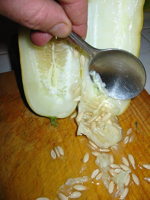
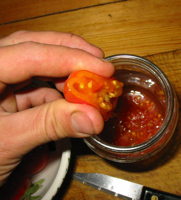
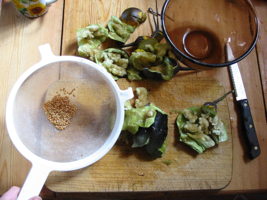
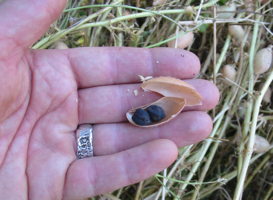
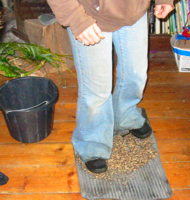
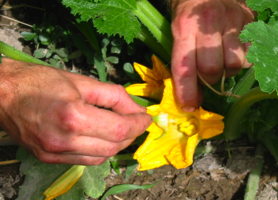
On the left-hand bar of every page of our website are a series of links to freely-copyable seedsaving instructions,
so check them out!
note: for a much deeper discussion of the economic issues raised here, try this link
Useful tools
As you can imagine, we have quite a lot of weeding to do, so our various hoes and other cultivation tools get a lot of use. We thought that other gardeners might be interested in a few of our favourites.
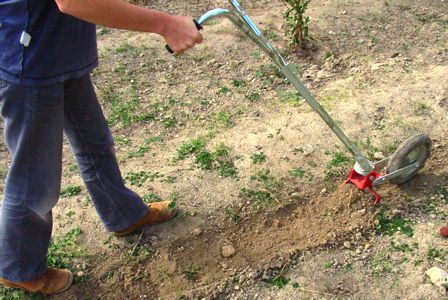 Wheelhoes
Wheelhoes
For general hoeing between rows, our wheelhoe gets a lot of use. A wheelhoe is exactly what it sounds like - a hoe, mounted on a frame with a wheel. You roll it along, and as the wheel takes the weight, the only effort is a push-pull motion to cut the weeds.
They're fantastic if you have a big plot - say allotment size or larger. You do have to plant all your crops in very straight rows, but then you simply push the wheelhoe up and down those rows, and you can keep a large area cultivated in a fraction of the time that it would take with a normal hoe.
Wheelhoes were popular in the early part of the last century for medium to larger scale vegetable gardening, and you may be able to find second hand examples that can be brought back to working order.
They come in various styles – one or two wheels, which may be small (pushchair size wheels) or large (bicycle size). You could potentially also make your own if you have the skills and time.
They can also be bought new, and come with various attachments including stirrup hoes, goosefoot hoes, ridging attachments, seeders, and others. Ours is a 'Pico', made by Glaser tools in Switzerland (they're sold in the UK by Blackberry Lane Tools).
 We have a few attachments for the wheelhoe, Kate prefers a goosefoot hoe (pictured right), but Ben likes to use an oscillating stirrup hoe. We also have a 3 tine cultivator, which is a hooked affair very useful for breaking up the soil & pulling out firmly rooted grass. And also hiller/furrower which we use to make furrows for planting, amongst other things, our various unusual tubers.
We have a few attachments for the wheelhoe, Kate prefers a goosefoot hoe (pictured right), but Ben likes to use an oscillating stirrup hoe. We also have a 3 tine cultivator, which is a hooked affair very useful for breaking up the soil & pulling out firmly rooted grass. And also hiller/furrower which we use to make furrows for planting, amongst other things, our various unusual tubers.
Although wheelhoes are mainly used for cultivating long rows, you can also get them with an offset attachment to the handle so that permanent beds can be hoed from the path. We've tried this ourselves, and it does work, but we found that it was quite a bit more work than pushing the hoe in a straight line through regular row crops.
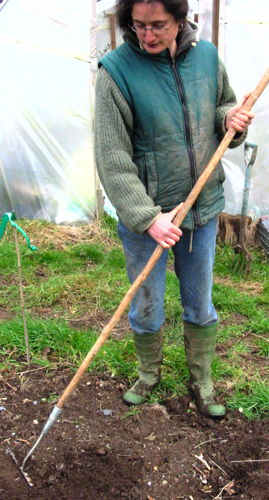 Hand hoes
Hand hoes
On a smaller scale, we have a good selection of hand hoes. Our Collinear hoe (designed by Eliot Coleman, and also available from Blackberry Lane) is great for hoeing between plants if we get there in good time and the weeds are still small.
It is a very lightweight sharp hoe, that you use in a 'sweeping' motion, almost as if you were using a broom.
Most people seem, when handed a hoe, to naturally grip it with both thumbs pointing downwards - which leads to a bent over working stance and a ‘chopping’ motion.
In contrast, the collinear hoe is designed to be held in a 'thumbs up' position, with a straight back - as demonstrated by Catherine on the right.
This is much faster, less hard on the back, and more precise. But it only works while the weeds are small. 5 minutes with the collinear hoe will save you hours of hand weeding later.
Actually, once you get used to this position, you may find, as I did, that you naturally move to using all hoes this way, and that your back benefits from the change.
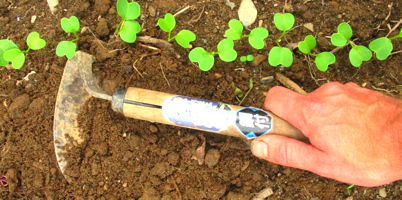 Small Hoes
Small Hoes
When things get really bad, we have a few hand hoes that we really like.
We have found that Japanese weeding tools are excellent - lightweight and sharp. They are made with two layers of special steel forged together - the soft springy steel backs and reinforces a super-hard layer that holds a wicked edge.
Here it is weeding along a row of baby turnips. The edge at the top, next to the baby plants, is not sharp and so there is less risk of accidental disasters!
The crucial thing that we find with all of our hoes is to sharpen them regularly to keep a really good edge, so that they slice through the weeds, rather than dragging them out of the ground.

Reducing Our Footprint - one step at a time. . .
The Real Seed Catalogue is not your usual 'limited company'. We have no shareholders, so we are not forced to do everything we can to maximise 'profit' at the expense of the environment. As part of our ethical policy, we keep trying to reduce our impact all the time. Part of that is to look at everything we do, and think, 'how can we do it better for the long-term health of the environment?'
One thing we worry about is the amount of plastic waste - which eventually, after the next ice age scrapes open all the landfill sites - will be floating in the sea. There's already a floating mat of tangled plastic the size of France in the middle of the Pacific, just from what gets dropped in the street and washes offshore in streams & rivers. So we would like not to be responsible for lots more.
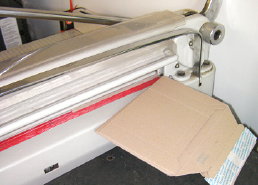
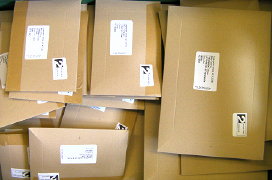 We used to use padded bubble-envelopes for sending out the seeds - but while they are very light, they simply will not rot down.
We used to use padded bubble-envelopes for sending out the seeds - but while they are very light, they simply will not rot down.
So we switched to cardboard mailers for almost all our orders this year. It costs us about 20p more per order, which we have absorbed without increasing our postage costs, but we think it is worth it.
Your cardboard mailer can simply be composted or recyled once you have done with it. Or if you send it back to us with your order in it, we will re-use it.
We then discovered that we could further cut our packaging by 50% by the simple method of Felicia putting the cardboard mailing envelopes through the guillotine and cutting them all in half! Most orders still fit in the tiny envelopes, and there is 50% less manufacturing and transport pollution involved.
Finally, we found a source for paper-based packaging tape, with solvent-free adhesive. So you can happily burn, compost, or recycle the tape along with your cardboard mailing envelope.
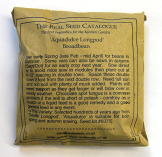 We are still trying to solve the issue of the little plastic baggies the seeds themselves come in. The problem is that all the other options are not water-proof and the seeds slowly absorb moisture from the air. One of the reasons our germination rates are good is that we get the seeds really nice and dry before we pack them, so breathable packets would lose that benefit.
We are still trying to solve the issue of the little plastic baggies the seeds themselves come in. The problem is that all the other options are not water-proof and the seeds slowly absorb moisture from the air. One of the reasons our germination rates are good is that we get the seeds really nice and dry before we pack them, so breathable packets would lose that benefit.
However, we have been experimenting for a while now with using paper packets for really large seeds such as peas and beans. The larger seeds don't absorb moisture very quickly at all, so they seem to be fine in paper packets. This should save about 10,000 plastic baggies a year from now on, and you'll see a gradual change-over this autumn as we pack new seed.
Of course, the best solution environmentally would be if you kept your own seeds at home, swapped them with your neighbours, and we didn't have to post them all over the place.
This is why we only offer real, non-hybrid seed, and why we supply seed-saving instructions with every packet, so you can save good, true-to-type seed at home. It is pretty easy and you really will get good seed if you follow the basic instructions. Why not give it a go this year?
In the Kitchen . . .
Our various unusual tubers are always amazingly popular (apologies to those who have found them sold out before they got there). For those of you who have been growing the yacon this year, and are wondering what different things you can do with your harvest of tubers, Felicia has been researching (and making and eating!) Yacon syrup, and also has a few other delicious suggestions. Here is her report:
Making your own sweetener - syrup from Yacon
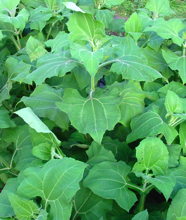 Yacon syrup is made from the tubers of this tall annual plant. It tastes very sweet in a distinctive way, somewhere between treacle and honey but completely different. It’s probably the easiest sweetener to grow and produce yourself in a British climate, since this tuber is much easier to juice than sugar beet. You can download a comprehensive scientific review of its chemical composition from here.
Yacon syrup is made from the tubers of this tall annual plant. It tastes very sweet in a distinctive way, somewhere between treacle and honey but completely different. It’s probably the easiest sweetener to grow and produce yourself in a British climate, since this tuber is much easier to juice than sugar beet. You can download a comprehensive scientific review of its chemical composition from here.
Yacon syrup is made with an evaporator for commercial scale production, but you can make it at home with just a juicer, a pot and a heat source. You will need approximately 30 kilos of yacon pulp to make one kilo of syrup. I estimate that the yacon plants we grew outdoors in Pembrokeshire produced somewhere between one and five kilograms of yacon each, but I have been told by a reliable source that he managed to get 25kg per plant by growing them in a polytunnel in Cornwall!
Making the syrup is very easy, but quite time consuming and energy intensive. You simply juice the tubers in a juicer that’s sturdy enough to handle beetroot. Then you heat the juice in a pan until all the moisture has evaporates and it reduces down to the consistency of maple syrup: a gloopey liquid that oozes slowly off your stirring spoon.
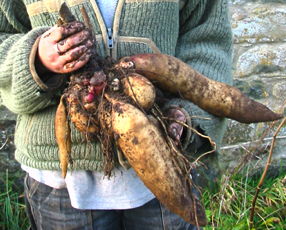 A raw-food website informs me that this syrup counts as raw, since the juice needn’t be heated to more than 40 degrees celcius (104 fahrenheit). We made our yacon syrup on a woodburning stove, so the temperature was very variable and it did come to the boil at one point. I think that all you need to do is to make sure it doesn’t burn at the bottom by stirring it every so often, but the lower the heat the longer it will take to make. It took our burner more than two hours to reduce our yacon juice down to about 500ml of yacon syrup.
A raw-food website informs me that this syrup counts as raw, since the juice needn’t be heated to more than 40 degrees celcius (104 fahrenheit). We made our yacon syrup on a woodburning stove, so the temperature was very variable and it did come to the boil at one point. I think that all you need to do is to make sure it doesn’t burn at the bottom by stirring it every so often, but the lower the heat the longer it will take to make. It took our burner more than two hours to reduce our yacon juice down to about 500ml of yacon syrup.
We didn’t seal our jars of syrup very well, so it only kept for about two months before developing a very strange smell. The yacon syrup available in our local healthfood shop has a use-by-date of more than a year though, and I presume that if you bottle it and sterilise it as you would bottled fruit then it would keep for a long time. Refrigeration after opening is recommended by professional yacon syrup people, but we don’t have a fridge and our open yacon syrup kept just fine for several weeks.
In any case, the tubers keep well all winter long if kept in a cool, dry place. I ate the last juicy yacon (harvested last December) raw at the end of April, and it still tasted fresh. If you can’t be bothered to make syrup, I recommend slicing yacon thinly and eating it raw immediately. Otherwise it discolours, but that can be stopped with lemon juice if you would like it to keep its nice crispy white colour for longer. Other favourites include using yacon instead of carrots in any carrot cake recipe, or frying it hard with lots of tamari… much simpler and quicker than making syrup!
NOTE - although we usually offer some each year, yacon is only available after November.
No way to pre-order, as we never know what the harvest will be like , so just keep checking the website.
Keep sowing through the summer!
Just a reminder for new gardeners - to avoid getting a huge glut in summer, and then nothing to eat later in winter, it is important to spread out your sowing over the year.
To help you plan your garden over the summer, we have a summer sowing guide, and also a less detailed month by month sowing guide that goes right through the year.
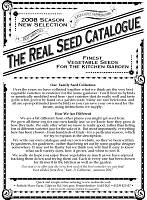 That's it for 2010... until the new catalogue:
That's it for 2010... until the new catalogue:
We hope you have a really good gardening year and that you manage to save some of your own seed at home, and perhaps even start breeding your own varieties.
Ben, Kate & Felicia, June 2010
(If you've enjoyed this newsletter and you're new to Real Seeds, you might like to have a look back at our earlier newsletters which have lots of articles and some nice recipes in them too.)






